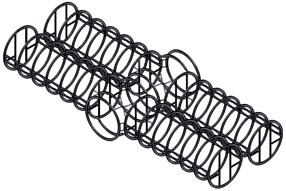

Phase II

Objectives
- Add 3 additional LGH units to the existing LGH1 unit, enclose the interconnecting hallway, and then evaluate performance and document operational requirements of the four units in terms of water, carbon, energy and radiation balance, as well as, determine food production.
- Demonstrate and evaluate water and biomass waste recycling through composting.
- Advance the monitoring capability of LGH1 by integrating the crop health/growth monitoring with non-contact and wireless technologies.
- Develop telepresence decision support system for operations control of the LGH1 unit.
- Evaluate performance and impact of Fresnel Solar Concentrator Power System (SCSP) for non-PAR electrical power generation and thermal energy collection.
- Develop national and international cooperation with researchers and students.
Deliverables
1. LGH unit expansions and performance analysis
- Provide water recycling quantity and quality
- Provide plant production characteristics, including fresh and dry weights per unit time, volume, and input resources, as well as, a subjective accounting of plant quality
- Monitor the flows of consumables including electrical energy, carbon dioxide, water, and labor, transformed into targeted products and byproducts
- develop control and cropping strategies
[Giacomelli1, Kacira1, Sadler1, Patterson, undergraduate student]
2. Composter-Wick-Evaporator (CWE) - Evaluate:
- Grey water stimulant processing
- Biomass degradation rate, fresh and dry weights per unit time, volume, and input resources
- Energy balance for condensing, heating, and operation
- Labor requirements, for the onsite rotary drum composter unit
[Sadler1, Hogan, graduate student]
3. Solar Concentrated Power System (SCPS) - Using the onsite Himawari:
- Monitor PAR light collection over time
- Initial investigation of non-PAR electrical power generation and thermal energy collection
[Furfaro1, Sadler, undergraduate student]
4. Remote Experts Network and Decision Support System (RENDSSys)
- Improve the monitoring and control capability of the LGH1 with additional non-contact sensing and telepresence technologies
- Integrated with a decision support system
[Kacira1, Story]
5. Energy Cascade Model
Continue development of the modified energy cascade model for a multi-crop lunar greenhouse system in conjunction with Italian collaborators.
[Lobascio1, Kacira, Boscheri, Furfaro]
6. Outreach
Demonstrate capabilities of the food production, water and atmosphere revitalization and generate off-campus interest in future lunar science outpost missions. Outreach with telepresence technology to NASA (STEM students), Land-Grant, UA-CEAC stakeholders, and university-level BLSS education.
[Giacomelli1, Kacira, Patterson, Sadler, Furfaro, graduate and undergraduate students]
(1primary)
© 2009-2013 UA-CEAC
Created by David StoryManaged by Story, Kacira, and Giacomelli